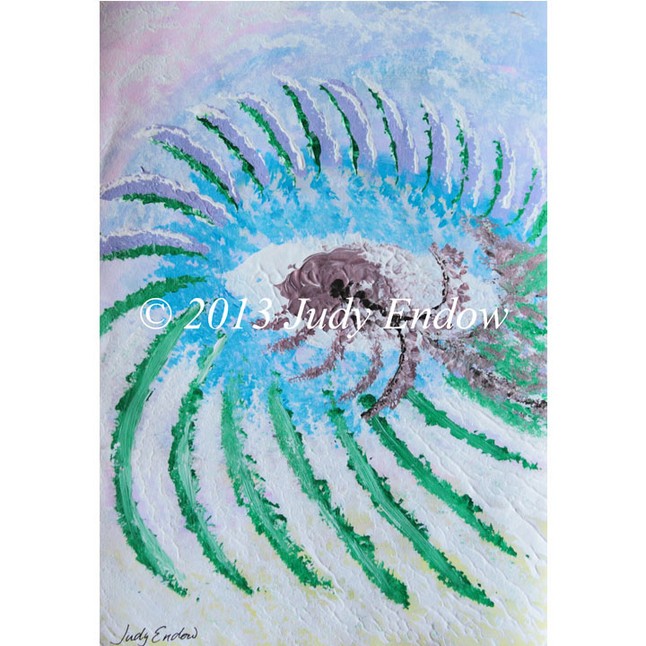A challenge I am continually faced with as an autistic adult is the misinformed presumption and resulting behavior of neurotypical people when I do not look at them the in way they expect, want or demand of me. It is challenging because society has put the onus on me to change. Often it does not matter to others why I am different. They just want me to stop being different. Recently I was told directly, “If you want to be treated like a real person then act like one!”
Eye contact can be hard for autistics for a variety of reasons. When I was a youngster I received too much bright, bold, painful sensory information from making eye contact. To guard against the intense physical pain I did not engage in eye contact. If my teacher demanded eye contact I obediently did so, but at a price. I would float out of my body, hover up near the ceiling and look down, watching the little girl of me (Endow, 2013).
Donna Williams says, “Dissociation is the ability to cut off from what is happening around you or to you. In its simplest form it is daydreaming. It is a skill all children have and which children with autism tend to overdevelop in managing a world they find overwhelming for a whole range of reasons” (Williams, 2014).
Today, 50+ years later, I am able to use eye contact in a manner that can appear typical most of the time. My sensory system has changed over time and eye contact does not produce as much pain as it once did. When I am well regulated I can manage the moderate pain I do experience from eye contact in my day-to-day life. However, avoiding eye contact is something I automatically do to minimize the amount of incoming sensory information and thus cut down on pain. I have to remain on high alert so as to catch when I am automatically moving into this eye contact shut down mode or I will not even know when it is happening.
I think it is unfair in our society that even though something like eye contact can be physically painful for autistics and that even when we endure the pain we are not able to pick up social information from eye contact. We do not choose this, but it is one of the ways our autistic neurology can operate. Yet, even when people know eye contact can be painful and that we will not pick up much social information, we are STILL expected to perform the feat for the social comfort of others. Each time we don’t perform the socially expected eye contact people assign negative character attributes to us such as shifty, sneaky, untruthful, disinterested and hiding something.
Because of the inflexibility of society I find, as an autistic, I need to make accommodations for the neuromajority who get stuck in these erroneous assumptions. If I fail to accommodate them I wind up not only being thought of poorly, but I am given less opportunities, less job promotions, and less social and business invitations to events. In turn, this affects not only my quality of daily life, but also my ability to support myself with sufficient income.
I think it is wrong of society to negatively judge me by my lack of eye contact, but because they do and because I want access the onus has been on me to accommodate them. If you are autistic and need to outsmart the incorrect assumptions people make about you around your ability to employ conventional eye contact here are some things I have found helpful:
Fake Them Out
In this strategy I look at some place on another person’s face that is close to the eyes, but not directly into the eyes. This can be a person’s eyebrows or hairline. Practice with a friend by having your friend tell you when you are looking at him and when you are not as you employ looking at different spots on his face rather than his eyes.
Secretly Spy on Them
In this strategy I watch TV programs or video clips of scenes from TV shows where people are making eye contact so I can see what it is that people expect. With video you can stop, pause and replay as much as you like. This is much more helpful than to try to learn from the fleeting glances of eye contact that take place in real time which are often gone before my autistic brain can even start to process them. It is a good idea to have someone you trust help you find video clips that are considered typical eye contact because this strategy can backfire if you learn some eye contact that would be inappropriate for general everyday use.
Give Them an Experience
This strategy provides a simulated experience that allows other people to understand how they might feel if they needed to abide by a social rule that did not come naturally to them. You can simply tell this story and invite people to imagine it or you might invite them to actually try it for a few minutes. Here is the script:
New Rule: No Looking at People
Imagine how you might feel if you were asked to stop looking at people – to cease all eye contact. Now imagine how much more difficult that would be if each time you did manage not to engage in eye contact you felt physical pain and the only way to relieve that pain was to look at the person even though you knew it would make others unhappy. This is often what we put autistics through when we insist they go against the way their brain does business by forcing them to use typical eye contact” (Endow, 2013).
Self-Advocacy Script
If eye contact is at times so physically painful as to be impossible it can be helpful to explain why you are avoiding eye contact quickly and effectively to people so they will not assume negative character traits and consequently afford you less opportunities in life.
In conclusion, I think it totally unfair that the burden of accommodation falls on the autistic when it comes to eye contact. In my estimation it would be better if society could come to embrace neurodiversity, but because I cannot control society’s acceptance of my neurology I have figured out some ways to get where I want to go in this world, outsmarting John Q. Public’s limited and narrow beliefs, lack of Theory of (autistic) Mind and faulty attribution towards this autistic!
 Sizzle Pop is the tittle of the acrylic painting by Judy Endow. See art at www.judyendow.com
Sizzle Pop is the tittle of the acrylic painting by Judy Endow. See art at www.judyendow.com
BOOKS BY JUDY ENDOW
Endow, J. (2019). Autistically Thriving: Reading Comprehension, Conversational Engagement, and Living a Self-Determined Life Based on Autistic Neurology. Lancaster, PA: Judy Endow.
Endow, J. (2012). Learning the Hidden Curriculum: The Odyssey of One Autistic Adult. Shawnee Mission, KS: AAPC Publishing.
Endow, J. (2006). Making Lemonade: Hints for Autism’s Helpers. Cambridge, WI: CBR Press.
Endow, J. (2013). Painted Words: Aspects of Autism Translated. Cambridge, WI: CBR Press.
Endow, J. (2009). Paper Words: Discovering and Living With My Autism. Shawnee Mission, KS: AAPC Publishing.
Endow, J. (2009). Outsmarting Explosive Behavior: A Visual System of Support and Intervention for Individuals With Autism Spectrum Disorders. Shawnee Mission, KS: AAPC Publishing.
Endow, J. (2010). Practical Solutions for Stabilizing Students With Classic Autism to Be Ready to Learn: Getting to Go. Shawnee Mission, KS: AAPC Publishing.
Myles, B. S., Endow, J., & Mayfield, M. (2013). The Hidden Curriculum of Getting and Keeping a Job: Navigating the Social Landscape of Employment. Shawnee Mission, KS: AAPC Publishing.
ADDITIONAL RESOURCE
Williams, D. quotation viewed 2014 on web site page www.donnawilliams.net
Originally written for and published by Ollibean on October 28, 2014



